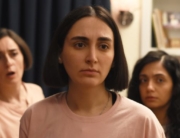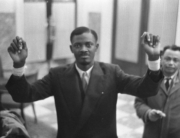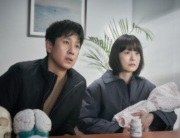The Painting begins with the image of an empty picture frame that expands to fill the screen. It’s a succinct statement of the film to follow, which has all the charm and depth of a well-executed canvas. It takes place primarily within a half-completed work, where characters argue about whether or not the painter will ever return to finish his work. Here, social strata are based on the degree of each figure’s completion: at the top are the “Alldunns,” aka the completely painted, followed by the “Halfies,” and then the “Sketchies.”
The latter are the film’s most touching rendering, bundle of threadbare lines prone to coming discombobulated when encountering more substantially painted objects. They hide within the palace of the Alldunns by taking advantage of their own malleable abstraction, mimicking decorations with ingenious simplicity. When one of them is caught, the resultant violence reduces one Sketchie—a friendly fellow named Gum—to a pile of smudges that can be picked up and tossed around like a crushed can. It’s a thrilling fusion of concept and execution which never quite finds another equal in the movie.
Our protagonist in this world is a Halfie named Lola, who, like many past animated heroes and heroines, wants to move beyond the boundaries of her world. She’s a pleasant enough character to spend time with, if lacking the kind of particularity or strength of personality that would render her memorable. But she’s just a little more restless than the other Halfies, which is enough to propel the whimsical, minimal story forward.
When an Alldunn, Roma, is expelled from his caste for his romantic entanglement with a halfie, he, Lola, and Quill end up on the lam together, running for their lives while their kindred are rounded up like cattle. Together, they venture past the edges of their painting into the confines or expanses of the real world—depending how you look at it. Director/animator Jean-François Languionie distinguishes well the shifts in reality, moving from the fanciful animation of the painting to a more realistic style for the studio in which the paintings reside, followed briefly by live-action photography at the end.
All of the visuals are lovely, the hand-painted style reminiscent of another time, place, and era of filmmaking. The painter’s studio feels equally like a throwback, a world without the distractions of modern technology. This accounts for the film’s charm as well as some of its shortcomings. The lesson to be learned here—individual empowerment, more or less—feels less purposeful than incidental to the events of the story. The broad strokes of the narrative feel oriented toward children, though in this age of immensely sophisticated children’s entertainments, even children might find something a little thin about the proceedings.
There’s not much to become invested in beyond the beauty of the conceit, and the most lasting images are ones that have little to do with the plot. An encounter with giant, ominous flowers provides a chance for a flight of visual fancy, and a beautiful, half-dressed woman, painted in the style of Matisse, speaks about the painter’s loving adoration for her. This latter episode is ripe with desire and self-confidence that would be startling in the context of a children’s film if they were not so candidly and deftly deployed. It’s a welcome relief to encounter a character so fully developed.
The lucidity and care with which this daydream is drawn is enchanting. There are several kinds of parables at work here—of equality, of superficiality, and most memorably, of curiosity and self-determination. None are investigated with rigor, but for the story to have leaned too hard on the ideas swirling about may have pushed the film’s lovely simplicity past the breaking point. The handcrafted feel is part of its charm and its purpose. It’s easy to let yourself drift along with it for as long as it lasts.







Leave A Comment